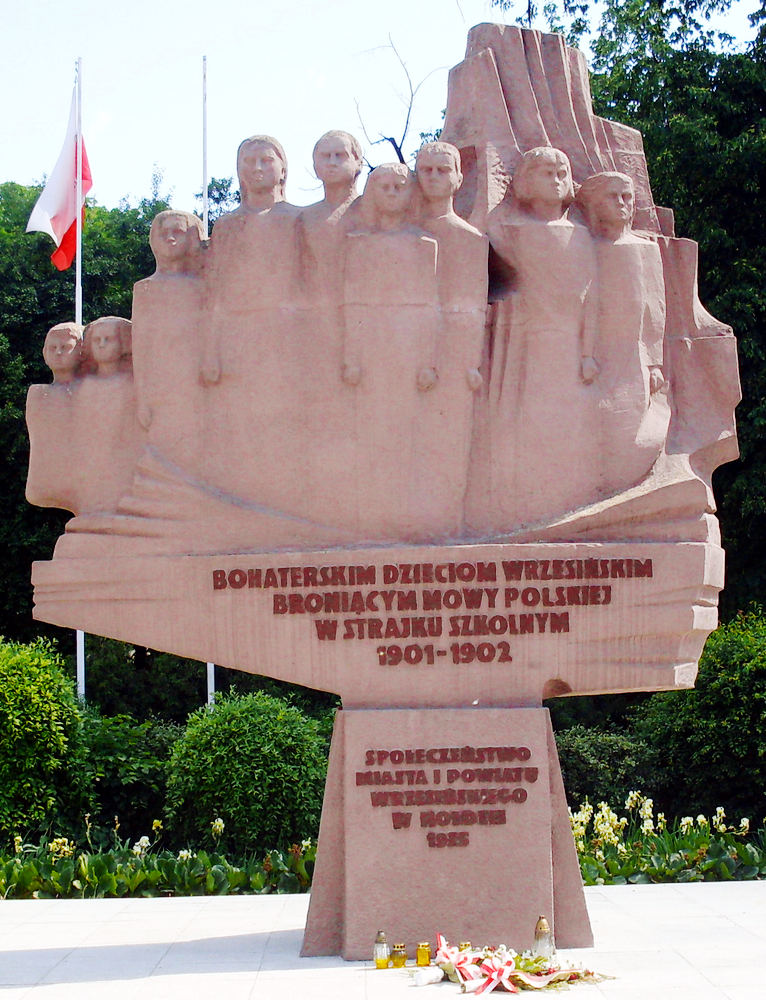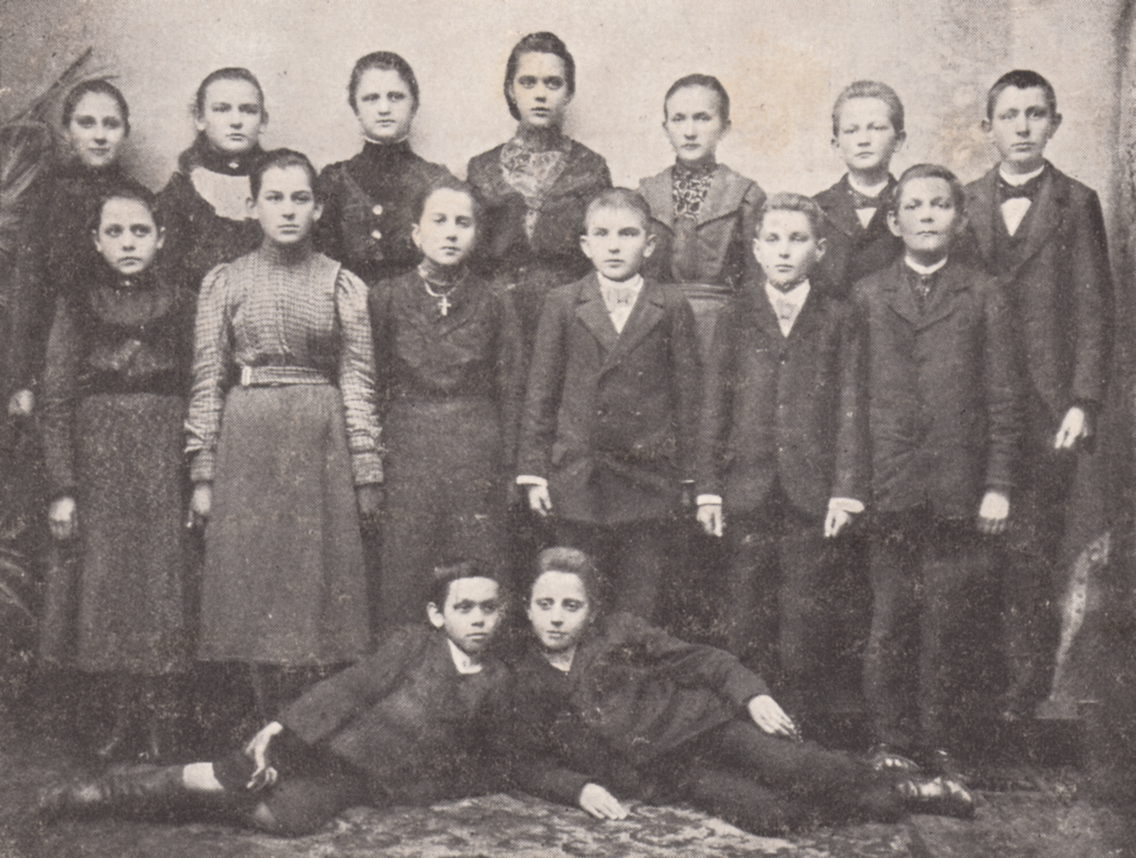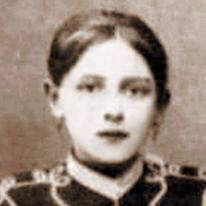2021 Remembering Września Children Strikes (1901-1903)
 The main ceremony commemorating the 120 anniversary of the 1901-1903 wave of protests against elimination of Polish language in Polish schools took place at the Września Children Monument in Września, Poland
The main ceremony commemorating the 120 anniversary of the 1901-1903 wave of protests against elimination of Polish language in Polish schools took place at the Września Children Monument in Września, Poland
Public domain via Wikipedia Commons
Września Children Strikes
Fighting for the Right to Speak Polish
Irena Frączek
After centuries of quiet obscurity, a little town of Września in west-central Poland, suddenly started making headlines across the world. The year was 1901, a cause célèbre was a group of brave Polish children rebelling against the ban on using Polish language in Prussian schools – ultimately throwing an unforgiving spotlight on the abhorrent and ruthless nature of germanization policies in the Prussian partition of Poland.
Września is located in Greater Poland (Wielkopolska), about 30 miles south-east of Poznań, and 15 miles south of Gniezno, two historically Polish cities vying for the title of the first capital of Poland. The Gniezno and Poznań region fell under the Prussian rule in 1793, in the course of second partition of Poland (ending also the short life of May 3 Constitution enacted in 1791).
From Prussian perspective, Polish inhabitants of the annexed area stood in the way of German eastward expansion (Drang nach Osten), a medieval idea that German nationalists eagerly embraced in the 19th century Prussian Kingdom. The main strategies for doing away with the obstacles on their course was eradication of Polish land ownership and unrelenting suppression of Polish culture and religion (Kulturkampf).
Step by step, Poles and Polish language were being removed from administration, courts, cultural institutions and academia. In secondary and elementary schools, restrictions on teaching in Polish were gradually introduced in the increasing groups of subjects and by 1873, only religion could be taught in Polish. Then in March 1901, a mandatory switch to German was ordered.
In Września’s Catholic People’s School (Katolicka Szkoła Ludowa), implementation of the new rule began with the arrival of re-printed catechisms on April 1. Yet children declined to accept the books and refused to speak German in religion classes. Children were disciplined by spending time in isolation rooms but facing an implacable defiance, unscrupulous German teachers turned to caning. On May 15, a town meeting with prominent politicians was held and a solemn note of disapproval was sent to the authorities. Then the situation escalated to the explosive level just five days later.
 Szymon Furmanek’s photo of children striking in Września. Due to high demand and orders arriving from all partitions in Poland and from abroad, the photo was reproduced on postcards. Children striking in Września sent some of the postcard to other schools as invitations to join the strikes) Public domain via Wikipedia Commons
Szymon Furmanek’s photo of children striking in Września. Due to high demand and orders arriving from all partitions in Poland and from abroad, the photo was reproduced on postcards. Children striking in Września sent some of the postcard to other schools as invitations to join the strikes) Public domain via Wikipedia Commons
On May 20, the teachers subjected 14 students to prolonged beating. Hearing the screams of children flogged inside, desperate parents and other concerned citizens tried to enter the school to stop the brutality. The school called police to disperse the crowd and in the aftermath, 26 adults were put on trial for public disturbance, rebellion, interference with public duties and criminal offences against the state. The so-called “Gniezno trial” ended on November 19, 1901 with sentences of imprisonment for 20 defendants ranging from 2 months to 2.5 years. The harshest penalty went to the impoverished woman taking care of her 7 children and elderly mother.
Despite the inconceivable hardship for the defendant’s families, the Leipzig tribunal upheld the ruling on April 12, 1902. The most defiant children were forced to stay in school for one year longer than required by law. The authorities also went after the committees organizing aid to the affected families. New court cases were filed against a school physician who certified the seriousness of children injuries and other witnesses testifying earlier for the defense. Even the local photographer Szymon Furmanek was sentenced to 40 days in jail for taking just three pictures of people involved in the drama. Two other people were slapped with lesser sentences for storing and distributing the photos.
Despite the trials, continuing use of corporal punishment and other repressions, children strikes spread to larger areas. They started waning after amnesty was declared in 1903, yet the last holdouts held tight until the summer of 1904. A new wave of strikes in 1905 engulfed about 800 schools in Poznań and Bydgoszcz regions. The last surge of strikes took place in years 1906-1907 with participation reaching 75,000 students. But it was the spark of Września, where 159 children rebelled at the peak of activities, that left the deepest trace in the history of those events.

WISCONSIN WRZEŚNIA
connection
Tekla Dembiński (née Tomaszewska), one of the children striking in Września, came to Wisconsin in 1909.
She was born into a very patriotic Września family on September 12, 1888. Under the care of her father, Andrzej Tomaszewski, secret meetings took place in their home for her siblings and friends to learn Polish language and history. When Tekla began coming home late because she was detained in “school arrest” after classes and her hands started showing signs of beeting to the blood, her father joined other parents writing complaints to the authorities. Around Easter 1902, despite the death of her mother, she was ordered to stay in school for one extra year. By the fall 1902, she was one of the only two students still subjected to this punishment (another was Bronisława Śmidowicz, generally viewed as the strike leader).
Tekla came to the United States to join two of her older siblings*. On August 7, 1912 she married Tomasz Dembiński and focused her life on raising the family of 4 children. Following her death in Racine on January 17, 1978, she was buried in Saint Adalbert Cemetery w Milwaukee.
On January 14, 2021, a delegation of Polish government officials and Polonia activists placed flowers on Tekla’s grave to mark the 120 anniversary of Września strike (see David Rydzewski’s report from the event). But more needs to be done to preserve the memory of those historic events. For the immediate consideration, the inscription on Tekla’s gravestone has worn away and her resting place distinguishes itself as the only unmarked and decrepit grave in this section of the cemetery.
*Two of Tekla’s brothers made big contributions to the history of Poland and American Polonia. Franciszek Ksawery Tomaszewski (1881-1976) was a Polish journalist working in Chicago, Milwaukee and Detroit. Active in many Polish organizations, he was awarded the General Haller Swords Medal for recruiting volunteer soldiers to Haller’s Blue Army. Aleksander Tomaszewski (1891-1970) studied medicine in Berlin University but spend his life in military. Among numerous decorations, he received a Silver Cross of the Virtuti Militari (1922) for fighting in the Soviet-Polish war and British Defense Medal and War Medal 1939-1945.
The Września children strikes quickly gained widespread attention in partitioned Poland and across the world. Support for the children, parents and their defenders was overwhelming. This was true even for the heavily censored newspapers in Russian partition, where Poles were subjected to similarly relentless russification.
As it could be expected, German newspapers followed two different paths. In general, Social Democrats opposed the germanization policies on Polish lands, while nationalists defended them staunchly. The latter slant went on display in late 1901, when celebrated pianist Ignacy Jan Paderewski was booed and boycotted after declaring that proceeds from his concert in Germany will go to aid the Września victims. Needless to say, Paderewski refused to perform in Germany.
In Europe, the strongest reactions were linked to other great Poles. Soon after the Gniezno verdict, Henryk Sienkewicz (1846-1916), the word-famous grandmaster of Polish language and 1905 Nobel prize winner, condemned its flagrant injustice in an open letter to the German emperor. The letter was reprinted in British press along the articles brimming with contempt for the Prussian anti-Polish policies.
On the other hand, Maria Konopnicka (1842-1910), the greatest Polish female poet and writer of the time, and a soul acutely sensitive to the suffering of children, worked tirelessly to publicize Września events during her prolonged stays in Italy. In response, about 120,000 Italians signed petition condemning the atrocities perpetrated on Polish children by Prussian teachers. Konopnicka also wrote the vastly popular poem “About Września” and the memory of those events echoes in Konopnicka’s “Rota.” Viewed by some as a candidate for Polish anthem, it is one of the most important songs ever written in Poland.
American Polonia quickly became aware of Września events as well. Published alongside the emotionally charged appeal “to Polish mothers” penned by Henryk Sienkiewicz, the first reports in Polish-language press appeared in June 1901. The response of Polish-Americans was spectacular. Numerous organizations called their members to action. Almost immediately petitions started to circulate and organized protests began taking place in town halls and parishes of many major and smaller American cities. They peaked in January 1902 and according to some estimates, demonstrations in Chicago area gathered around 25,000 Poles and their supporters on just one day (January 26) alone.
These actions helped the Polish cause in more ways than one. Thousands of dollars collected to aid the children and their imprisoned defenders notwithstanding, the extent of oppression that Poles suffered in the partitioned Poland was most vividly brought to the attention of general public and the media. For individual Polish Americans, it was a chance to realize the strength of their spiritual connection to the ancestral homeland and native language. And for Polonia in general, an opportunity to experience the empowerment that arises from the organizational unity and the potency of symbols that conjure sympathy and support for Polish causes, while exposingy the true image of ruthless perpetrators.
Let’s pause and reflect on the significance of those historic events on their 120 anniversary.
Further readings in English:
Stewart Dowell: The children who were flogged to within an inch of their lives for refusing to pray in German
Stanisław A. Blejwas: American Polonia and the School Strike in Września
Archived Posts
- 80th Anniversary of the 1944 Warsaw Uprising
- 2024 Wianki Festival
- 2024 Polish Constitution Day in Wisconsin
- 2023 Merry Christmas
- 2023 Lighting the Light of Freedom on Dec 13 at 7:30pm
- Independence Day and Veteran Day invitation
- 2023 Wianki Festival
- 2023 May 3rd Constitution Day Celebration
- 2023 Lecture on Polish Borders by Prof. Don Pienkos
- 2023 REMEMBER THIS: Jan Karski movie premieres on PBS Wisconsin
- 2023 Upcoming lectures in the Polish Center of Wisconsin
- 2022 Polish National Independence Day
- 2022 Independence and Veteran Day Luncheon (invitation)
- 2022 Wianki, Polish Celebration of Noc Świętojańska (St. John’s Night)
- Celebrating Constitution of May 3, 1791 in Polish Center of Wisconsin
- 2022 Polish Constitution Day, Polish Flag Day and the Day of Polonia
- 2022 March Bulletin
- 2022 Polonia For Ukraine Donations
- 2022 Polish American Congress Condemns Russian Invasion of Ukraine
- 2022 PAC-WI State Division Letters to WI Senators and Representatives
- 2021 Polish Christmas Carols
- 2021 Panel Discussion: Martial Law in Poland 1981-1983 (REPORT)
- 2021 Panel Discussion: Martial Law. Poland 1981-1983 (invitation)
- 2021 Solidarity: Underground Publishing and Martial Law 1981-1983
- 2021 Polish Independence Day and Veterans Day
- 2021 Polish Independence Day and Veterans Day Luncheon
- 2021 Prof. Pienkos lecture: Polish Vote in US Presidential Elections
- 2021 POLISH HERITAGE MONTH EVENTS
- 2021 “Freedom” Monument Unveiled in Stevens Point, Wisconsin
- 2021 PCW Picnic and Fair
- 2021 Remembering Września Children Strikes (1901-1903)
- 2021 May 3 Constitution Day
- 2021 DYKP Contest Winners and Answers
- 2021 DYKP CONTEST EXTENDED and CASIMIR PULASKI DAY
- 2021 February announcements
- 2021 Polish Ministry of Education and Science oficials visit Wisconsin
- 2021 DYKP Contest, KF Gallery and Dr. Pease lectures
- 2020 Help Enact Resolution commemorating the 80th Anniversary of the Katyn Massacre
- 2020 Independence And Veterans Day
- 2020 Remembering Paderewski
- 2020 POLISH HERITAGE MONTH
- 2020 Solidarity born 40 years ago
- 2020 Battle of Warsaw Centenary
- 2020 The Warsaw Rising Remembrance
- 2020 June/July News: Polish Elections, Polish Films Online and more
- 2020 Poland: Virtual Tours
- Centennial of John Paul II’s Birth
- 2020 Celebrating Polish Flag, Polonia and Constitution of May 3rd
- 2020 Polish Easter Traditions
- 2020 Census and Annual Election
- Flavor of Poland (Update 3)
- 2020 Copernicus, Banach & Enigma talk
- 2020 Do You Know Poland and other announcements
- 2020 Flavor of Poland (Update 2)
- 2020 People and Events of the Year
- 2019 Holidays
- 2019 December Medley
- 2019 Independence Celebration
- 2019 Independence Invitation


